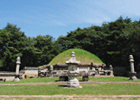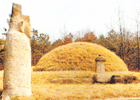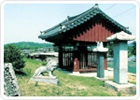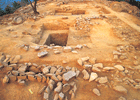Tangibale cultural property
Donggureung

- Nationallydesignated historic cultural property No.193
- Location197 Donggurungro, Guri City
- Closedon Monday
When King Taejo Lee Seong-gye who founded Joseon Dynasty passed away in 1408 (8th year of King Taejong), King Taejong ordered to seek for fine site for tomb in Paju, Goyang and others. Kim In-gwi who was the governor of Uijeongbu recommended the area with the decision made by the prime minister Ha Ryun. The building up of Donggureung has been made throughout the time of Joseon Dynasty. The name of Donggureung came in 1866 (6th year of King Cheoljong) when su-reung, the tomb of Chujonwang King Ikjong was built, and it had been called as Dongohreung and Dongchilreung. In Donggureung, there are nine tombs, including Geonwon-reung, the tomb for King Taejo Yi Seong-gye, Hyeon-reung (5th King Munjong and his queen, Hyeondeok Wanghoo), Mok-reung (14th King seonjo and his Queen, Ui-in Wanghoo, and Inmok Wanghoo), Hui-reung (16th King Injo’s Queen, Jangryeolwanghoo), Soong-reung (18th King Hyeonjong and his Queen, Myeongseong Wanghoo), Hye-reung (20th King Gyeongjong’s Queen, Danui Wanghoo), Won-reung (21st King Youngjo and his Queen, Jeongsoon Wanghoo), Soo-reung (23rd King Sunjo’s Prince Chujonwang King Ikjong and his Princess, Sinjeong Wanghoo), Gyeong-reung (24th King Heonjong and his Queens Hyohyeon Wanghoo, and Hyojeong Wanghoo).
Myeongbinmyo(Tomb of Myeongbin)

- Nationallydesignated historic cultural property No.364
- LocationSan 14, Acheon-dong, Guri City
Myeongbin-myo is the tomb for Myeongbin Kim who was a royal concubine of the 3rd king of Joseon Dynasty, King Taejong. Myeongbin (?-1479) was a daughter of high government official Kim Gu-deok, with the family origin in Andong. In November of the 11th year of King Taejong (1411), she was appointed as Myeongbin. Notably, she kept the inner affairs of the royal family from King Taejong to King Seongjong until she passed away on June 5 in the 10th year of King Seongjong (1479). She did not have offspring from King Taejong. In the tomb site in Dongsa-gol, Acheon-dong, the tomb site is built on 2,500 pyeong of size, and there are one stone mark, one pair of literary stone, upper stone (honyuseok) with the incense burner and others. It was designated as the historic site on October 25, 1991.
Sindobi of Na Man-gap

- NationallyGyeonggi-do tangible cultural property No.126
- Year of establishment1658 (9th year of King Hyojong)
- Date of designationJune 28, 1985
- LocationSan 163 Sano-dong, Guri City, Gyeonggi-do
Sindobi is the tombstone erected on the street near to the tomb of high ranking official with grade 2 or higher, and this is normally selected by the official who served as Grade 3 or higher position official. The family origin of Na Man-gap (1592- 1642) was Anjeong, with the call name of Mongroe, and his pen name was Gupo. He passed the National Examination on the fifth year of King Gwanhae-gun (1613) and became one of the scholars at Seonggyungwan. However, he came down to his hometown with the Exile of Inmok Daebi in West Palace for his studies. Later, he was appointed as Sunreung Chambong after the Injo Restoration in 1623. In the same year, he took the Alseong National Examination and passed in military division. Thereafter, where he was an official of Hongmungwan, he was demoted to Gangdong Hyeongam during the partisan party struggle. With the Jeongmyo Invasion in 1627 (5th year of King Injo), he was one of the guardians of King Injo in Ganghwa-do. After returning to the capital, he served various government positions and became the Hyeongjo Chamui to protect the king in 1635. After that he served the Byeongjo Chamui but was accused of wrong doing to be exiled in southern region, and died in 1639 in Yeongju, and thereafter, was appointed as Jwauijeong (one of three prime ministers). For his writings, there were Byeongjerok (Record of Byeongja), Gupo Collection and others. The writing on his Sindobi was written by Cheongeum Kim Sang-heon, additional writing by Dongchundang Song Jun-gil, with his grandson Yang Jwa written on the stone. In addition, his tomb mark had the writing by Wooam Song Si-yeol and location name written by Mungok Kim Su-hang. In June 28, 1985, it was designated as the tangible cultural property of Gyeonggi-do.
Borugun in the Achasan area

- Nationallydesignated historic cultural property No. 455
Achasan is a mountain in the Hangang River basin on the boundary line of Gwangjin-gu of Seoul and Guri City. It is not very high but is very important topographic place. The Hangang River basin is strategically important area while had great transportation to the west sea through Hangang River as well as having very rich plane that it has been well developed as the production, trading, politics and culture from the pre-historic era. In particular, during the Three Kingdom Era, this area was so strategically valuable that the future of each country was depending on who takes this area. Therefore, the Three Kingdom had competed to take this area. The one that took this place from the Three Kingdom was Baekje. King Onjo settled this area (BC 18) and controlled the region for five hundred years until the capital was moved to Gongju (Woongjin) in 475. In 475, King Jangsoowang of Goguryeo killed King Garoewang under Adan Fortress (Achasan) to take over Han Fortress of Baekje to take the land as far down as the south of Hangang River as the Goguryeo territory, but in 551, Silla and Baekje Allied force defeated Goguryeo to relinquish the Hangang River area, and in 553, it became the land of Silla.
Achasan has Jungryangcheon on the west and Wangsukcheon on the east to flow the water into Hangang River. Achasan is the highest peak in the area along with Yongmabong that it is very important military point with entire southern region of Hangang River on the south and Uijeongbu on the north in full view. Including the forts in Achasan and Yongmasan, there are several forts erected on the mountains lining up to Gui-dong Fort along the mountain ridges. These forts were built to monitoring Hangang River, Jungrangcheon, and Wangsukcheon, that, in particular, the southern region of Hangang River, Mokchon Toseong and Poongnap Toseong area, would be in full site for monitoring. A fort is a small military base that the Achasan area would have a total of 20 forts built in the past Achasan with the Goguryeo relics had been systematically surveyed by Guri City and Guri Culture Center in 1994 for the first time, and significant amount of relics were discovered in 1997, 1998 and 2000, and it was designated as the nationally-designated cultural property (historic site number 455) on October 27, 2004.